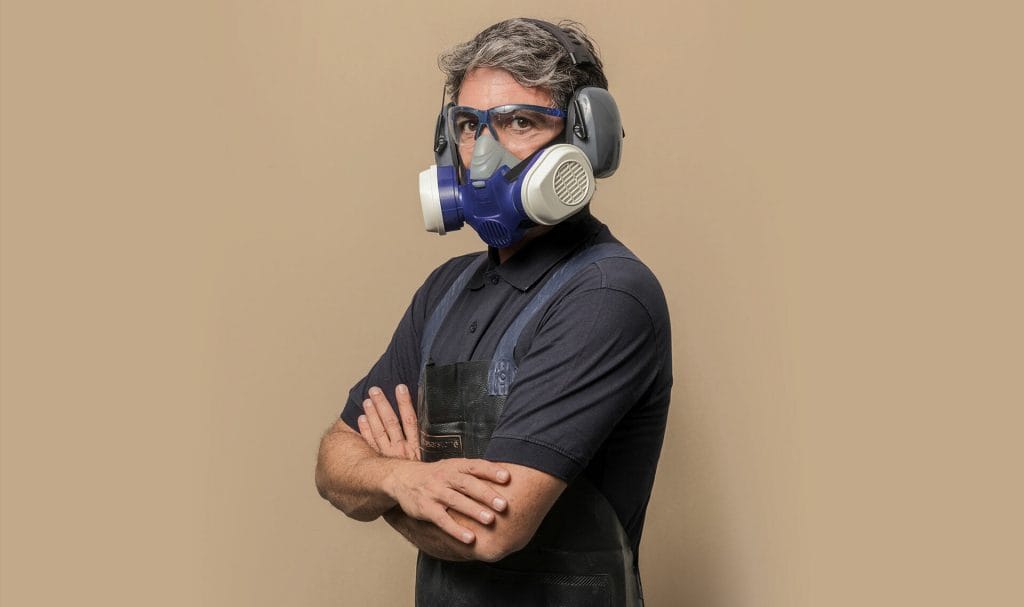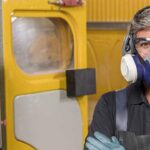
Caesarstone® Health & Safety
Caesarstone surfaces are in millions of homes around the world, and comply with the strictest standards of hygiene and sterility.
Overview
As the world’s leading global surface developer and manufacturer, the health and safety of our employees, suppliers, partners and communities are our first priority. As such, Caesarstone promotes safe working environments, free of hazards and in compliance with all local law.

In Summary, the key points are:
- We can assure you that Caesarstone surfaces installed in the home are absolutely not harmful to the consumer. They are completely safe.
- The health risk lies only in the fabricating procedure, if performed not in accordance with safety and legal requirements, and not in the surfaces themselves.
- Exposure to crystalline silica dust and the related risks that may result from such exposure can be reduced and controlled if the proper safety measures are implemented.
- Since 2008, when Caesarstone Australia began operations in Australia, we have provided the independent stonemason industry with information relating to the safe handling of our product and what safety measures should be considered to reduce the exposure to silica dust.
- Caesarstone will continue to actively promote and educate regarding safe handling of our products by stonemasons. The health and safety of workers in the industry is paramount.
- Caesarstone is a founding member of the NSW Government Taskforce as well as a member of the Queensland Government Code of Practice working groups to review and improve the industry’s safety standards and regulations. We are actively involved in several committees overseeing the National Dust and Disease Task Force recommendations for a safer industry and have participated in two university research projects relating to health and safety aspects of our industry.
- Since 2019, state governments have developed and published a code of practice for the stone industry and regulations that explicitly prohibit uncontrolled dry cutting of engineered stone. In 2022, the Victoria State Government implemented a licensing scheme for stonemasons who wish to work with engineered stone. Caesarstone is in full support of a regulated industry that requires a governed licensing scheme. We welcome these initiatives and note that Caesarstone’s own recommended safety standards and best practices have long urged stonemasons to follow strict safety protocols such as wet cutting and proper respiratory protection.
Find out more about our initiatives on health and safety information here
Below are answers to some of the most common questions:
Caesarstone Safety
Can Caesarstone surfaces installed in the home be harmful to the consumer?
We can assure you that Caesarstone® surfaces once installed in the home are absolutely not harmful to the consumer.
Caesarstone surfaces are completely safe for domestic and commercial use and comply with the strictest local and international safety standards for consumer use.
Caesarstone surfaces are used today in many domestic and commercial environments and meet the strictest standards and requirements of hygiene and sterility.
The health risk lies in the fabricating process (such as cutting, sawing and polishing engineered stone), if performed not in accordance with safety and legal requirements – and not in the surfaces themselves.
A small amount of silica dust may be generated during installation or repair of Caesarstone surfaces in the end user’s home, provided that installation is being performed according to state specific requirements for appropriate safety controls. However, this poses no health threat to the end user, since diseases related to silica dust develop only as a result of unprotected and uncontrolled ongoing occupational exposure to silica dust. Silicosis is purely an occupational disease.
Does Caesarstone meet industry standards for health and the environment?
Caesarstone always complies and collaborates with regulatory organizations to ensure that our benchtops meet with strict international safety standards for consumer use – whether for admiring or eating. Our benchtops are approved by the NSF (National Sanitation Foundation) for contact with food and bear other strict certificates and accreditations of regulatory and safety standards bodies including Greenguard, which ensures that a product has met some of the world’s most rigorous and comprehensive standards for low emissions of volatile organic compounds (VOCs) into indoor air.
Caesarstone surfaces maintain the most stringent industry standards for health and environment, as listed below, and as presented on the Caesarstone website.
- Caesarstone products are compliant with the National Sanitation Foundation International standard, ensuring that our working surfaces are safe for use in all food environments.
Caesarstone surfaces comply with ISO 14001, ISO 9001, OHSAS 18001 and ISO 45001.
- Caesarstone is a registered member of the United States Green Building Council (USGBC).
- Caesarstone surfaces comply with the American GEI (GREENGUARD Environmental Institute) certification, which primarily verifies that Caesarstone’s products meet the most stringent air emission standards.
- Caesarstone surfaces are kosher due to their low porosity.
Guide to Quartz, Silica and Silicolosis
What are Caesarstone surfaces?
Caesarstone surfaces (often referred to as engineered stone) are an advanced solution for kitchen benchtops, backsplashes and bathroom vanities. Historically these surfaces were manufactured using upwards of ~90% quartz and high-quality polymer resins and pigments.
As part of our ESG commitment, we are committed to developing environmentally friendly and low-silica products. We launched our low-silica based product into the market in 2022.
What are silica and quartz?
Silica is one of the most common compounds on earth.
Caesarstone surfaces are made of minerals that include crystalline silica, such as silica sand and quartz.
Crystalline silica commonly occurs in nature as the mineral quartz, and is found in granite, sandstone, quartzite, various other rocks, and sand. It is comprised of two chemical elements: silicon and oxygen (silicon dioxide; SiO2). It is a component of many manufactured products in daily use, such as glass, pottery and quartz surfaces; and of construction materials such as bricks, blocks, tiles, slabs, cement, ceramic and concrete.
Where is silica found?
Silica is one of the most abundant minerals found in the earth’s crust and is used in many products across a variety of industries and workplaces.
| Material | Percentage of silica |
| Marble and limestone | 2% |
| Concrete | 20-40% |
| Slate | 25-40% |
| Granite | 20-45% |
| Porcelain | ~40% |
| Natural sandstone (found in tunnelling, mining, construction) | 70-95% |
| Engineered stone | Up to 97% |
What industries work with silica and are exposed to silica dust?
It is important to point out that silica dust is found in many products in our day-to-day lives such as glass, ceramics, semi-conductors and many more.
Working with crystalline silica (quartz) is found in numerous industries including:
- Underground mining, tunnelling and excavation work
- Extraction and cutting of quartzite, gneiss, granite, sandstone and slate
- Foundries
- Glass manufacturing plants
- Brick making
- Manufacture of glass, pottery, porcelain, bricks, ceramic tiles, pavers
- Road building
- Building construction
- Demolition work where potential sites of silica exist e.g. breaking up concrete
- Explosive blasting work
Can silica be handled safely?
Yes. While the risk of RCS is well documented and understood, it is acknowledged that all silica-containing materials can be handled safely if proper procedures are followed and proper tools are used – in workshops and on-site. This extends to the fabrication of engineered stone; Dr Graeme Edwards, a senior consulting physician in occupational and environmental medicine and member of the National Dust Diseases Taskforce, has provided expert evidence that “the product can be fabricated safely”.
Existing safe handling tools and procedures include:
- Bans on dry cutting
- Water-integrated tools for wet-cutting
- High-quality dust extraction, filtering and monitoring
- Pressurised and non-pressurised masks
- Equipment with integrated dust collectors
To eliminate the risk of silicosis, these safety measures should apply to the handling of all silica-containing materials. The same safety measures used to cut and polish engineered stone must apply to cutting or grinding sandstone or any lower percentage silica stone, such as granite, marble and porcelain, on the basis that workers should not be exposed to dust containing any level of silica.
Caesarstone believes all cutting, grinding and shaping of engineered stone slabs should be carried out in workshops, where there are typically better safety controls. While slabs can be handled safely at installation sites when proper safety equipment is used and procedures are followed, if significant cutting is required the slabs should be returned to the workshop for re-cutting.
Silicosis is an incurable, progressively disabling and sometimes fatal lung disease. It is caused by unprotected and uncontrolled ongoing occupational exposure to respirable crystalline silica (RCS) particles, without the protective health and safety measures required by law.
Silicosis and other diseases associated with RCS are 100% preventable with the correct safety measures, such as wet cutting in place and the use of effective respiratory protection measures.
Silica Dust Hazard Control
Can crystalline silica dust hazards be prevented?
Yes. Exposure to crystalline silica dust and the related risks that may result from such exposure can be reduced and controlled if the proper safety measures are implemented. These measures include, among others, installing proper engineering controls (ventilation and filtration), working with CNC machines and water-injected tools, and using appropriate respiratory protection.
Duty holders must assess and ensure that occupational exposure to airborne crystalline silica dust is below the Workplace Exposure Standards (WES) of 0.05mg/TWA of 8 hours. Always apply your local laws and regulations regarding working in environments containing harmful dust.
In order to control and reduce/eliminate the health risks associated with crystalline silica, we recommend that a Silica Control Plan be implemented in the workplace in accordance with all the applicable laws, regulations, orders and directives. This program should be reviewed on a regular basis or whenever there is any change to the work environment or daily workflow.
It is important to note that the exposure and personal protection precautions are only necessary for the fabrication of Caesarstone products (cutting, sawing, polishing etc.), due to the dust that may be generated in the process, and not from the Caesarstone slab as a product.
The employer, Duty Holder or PCBU is responsible for providing his/her workers with all the information, tools and safety measures required to protect them from the dangers of exposure to silica dust. The workers are responsible for fully implementing the safety instructions. Access to the work area should be restricted to authorized employees only. By a joint effort of the employer and workers, the workplace can become a safe environment for everyone.
What information does Caesarstone provide to ensure safe working practices?
If you work with Caesarstone mineral surfaces, please download and read the following guides:
Caesarstone Fabrication & Installation Guide, Good Practice Guide and Safety Data Sheets (SDS).
We also encourage all fabricators to register with our MASTER OF STONE online Training Center, an innovative, unique, online learning platform, dedicated to making information and working guidelines on health and safety accessible to fabricators worldwide. The objectives of these Guides are to:
- Reiterate the information about the well-known risks and health hazards of working in an environment where respirable crystalline silica dust is created; and
- Remind you of certain information to assist in reducing workers’ exposure to respirable crystalline silica dust, including information on the safe use of products containing crystalline silica in the workplace and Personal Protective Equipment (PPE) that can be used, if necessary.
Furthermore, the instructions in these Guides are addressed to employers and workers who fabricate Caesarstone slabs in order to help them control their exposure to respirable crystalline silica dust.
It is important to note that the information provided in these Guides does not replace and/or specify all your local laws and regulations, which you must comply with and, therefore, you are required to be familiar with and adhere to all your local laws and regulations and consult with occupational health and safety professionals.
Caesarstone Industry Support
What has Caesarstone done in the past to support safe fabrication methods?
Over the years Caesarstone Australia has provided the independent stonemason industry with information about the safety measures required to be implemented when working in a silica dust environment.
Initiatives include:
- Recruited a dedicated health and safety team to partner with stonemasons on health and safety matters.
- Provided every stonemason who holds an account with Caesarstone with comprehensive instructions and information via the Caesarstone Fabrication & Installation Guide, Good Practice Guide and the Safety Data Sheets. Full documents are available for download via our website.
- Caesarstone supplies each individual slab to stonemasons with the relevant warnings, health and safety information prior to fabrication and installation.
- Conducted a series of workshops and roadshows across Australia, inviting a wide range of stonemasons to attend to receive training and updates on safe working practices.
- Implemented the MASTER OF STONE Training Center – an innovative, online learning platform, dedicated to making information and working guidelines on health and safety accessible to fabricators.
- Launched our national industry safety Newsletter allowing us to further partner with stonemasons on important safety matters.
- Updated invoicing system to include relevant safety information.
- Implemented a Health & Safety Compliance system for all new and existing account holders
- Partnered with regulator in order to promote health and safety compliance within the industry.
How is Caesarstone continuing to help improve safety practices in the stonemason industry?
Caesarstone is a founding member of the NSW Government Taskforce and the Queensland Government Code of Practice working group. Caesarstone continues to engage with Government Workcover agencies, unions, occupational physicians and the Thoracic Society, industry associations and State Health Departments, to ensure there is ongoing awareness of adequate safety standards and the importance of workplace monitoring.
In the last two years we have been actively involved in a number of university research projects, partnered with iCare to promote healthy industry workers and the importance of health monitoring.
Caesarstone will continue to actively promote and educate regarding safe handling of our products by stonemasons by implementing the following plans moving forward:
- Further reviewing and communicating our Good Practice Guide, SDS, and Fabrication & Installation Guide
- Forming the Australian Engineered Stone Advisory Group (AESAG) to ensure the industry is working closely together on the issue
- Developing a dedicated stonemason information website, including safety videos, to enhance communication with stonemasons
- Developing an occupational and medical referral list for customers
- Providing customers with government regulations and guidelines (federally and for each state)
- Increasing and improving customer communications via regular EDMs
- Conducting further training sessions to stonemasons about health and safety procedures
- Creating extra safety signage for customer work sites
- Enhancing current online training programs
State governments have developed a code of practice for industry and regulations that explicitly prohibit uncontrolled dry cutting of engineered stone and we are actively involved in promoting the regulatory guidelines.
How does Caesarstone protect the safety of its own employees?
Every Caesarstone production line employee receives comprehensive training regarding the safe handling of our products. In addition, safety guidelines are posted clearly throughout our manufacturing facilities. There are no production facilities in Australia as slabs are imported to this country. However, we train our sales staff who visit customer work sites and issue them with safety equipment for use when entering areas where the product is being fabricated. We have a comprehensive safety management system in place and conduct regular workplace inspections.
Download your copy of the Caesarstone Good Practice Guide, Safety Data Sheet and Fabrication & Installation Guide
Relevant Links
Useful Links – Law & Regulation
Safe Work Australia https://www.safeworkaustralia.gov.au/ is the national policy body responsible for the development and evaluation of model work health and safety laws.
The Commonwealth, states and territories are responsible for regulating and enforcing the laws in their jurisdictions. Australia does not have uniform regulations between the Commonwealth or states and territories.
For stonemasons, you should familiarize yourself with the laws applying in your state or territory as there may be variations between jurisdictions.
Further information on work health and safety regulations in each jurisdiction can be found online at the following links.
SafeWork NSW
https://www.safework.nsw.gov.au/
https://www.safework.nsw.gov.au/hazards-a-z/hazardous-chemical/priority-chemicals/crystalline-silica
Workplace Health & Safety Queensland
https://www.worksafe.qld.gov.au/
WorkSafe Victoria
https://www.worksafe.vic.gov.au/
WorkSafe ACT
https://www.worksafe.act.gov.au/
SafeWork SA
https://www.safework.sa.gov.au/
NT WorkSafe
WorkSafe WA
https://www.commerce.wa.gov.au/worksafe
WorkSafe Tasmania
https://www.worksafe.tas.gov.au/
Further information on health and safety is available from the Australian Government agency Comcare at http://www.comcare.gov.au/
| Document Name | Link |
|---|---|
| Commonwealth | |
| Work Health and Safety (Managing the Risks of Respirable Crystalline Silica from Engineered Stone in the Workplace) Code of Practice 2022 | Download here |
| Queensland | |
| Managing respirable crystalline silica dust exposure in construction and manufacturing of construction elements Code of Practice | Download here |
| NSW | |
| Code of Practice – Managing the risks of respirable crystalline silica from engineered stone in the workplace | Download here |
| Victoria | |
| Compliance code – Managing exposure to crystalline silica: Engineered stone | Download here |











